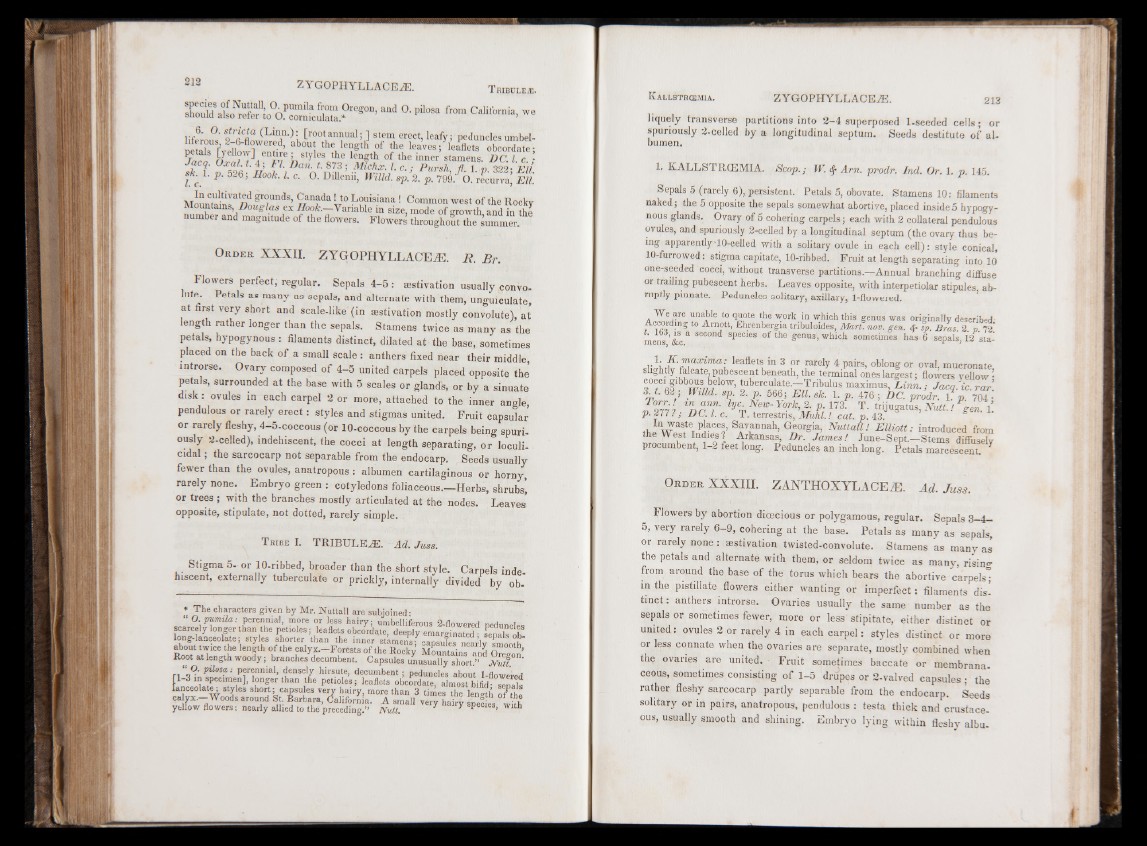
of’S c a S . . 0 '6*™’ “ d a pil°!* from C“li,brnk' " e
Jarn 0™ /T n styles0the lenSth of the inner Jacq. Oxal. t. 4j FI. Dan. t. 873 ; Michx. 1. c .; Purshst am/?.e n1 s.n D3C22. ■1 . Fc1.1;
s h l. p. 526; Hook. 1. c. O. Dillenii, Willd. sp. 2. p. 799. O. recurva’ Ell.
In cultivated grounds, Canada ! to Louisiana ! Common west of the Rockv
Mountains, Douglas ex Hbo*.-Variable in size, modTofJowth and in £
number and magmtude of the flowers. Flowers throughout the summer.
Or d e r X X X II. ZYG OPH YLLACEjE. R. Br.
Flowers perfect, regular. Sepals 4 -5 : aestivation usually convo-
lute. Petals as many as sepals, and alternate with them, unguiculate,
at first very short and scale-like (in aestivation mostly convolute), at
length rather longer than the sepals. Stamens twice as many as the
petals, hypogynous : filaments distinct, dilated at the base, sometimes
placed on the back o f a small s c a le : anthers fixed near their middle
mtrorse. Ovary composed o f 4 -5 united carpels placed opposite the
petals, surrounded at the base with 5 scales or gland's, or by a sinuate
d isk : ovules in each carpel 2 or more, attached to the inner angle,
pendulous or rarely e r e c t : styles and stigmas united. Fruit capsular
or rarely fleshy, 4-5-coccous (or 10-coccous by the carpels being spuri-
ously 2 -celled), indehiscent, the cocci at length separating, or loculi-
c id a l; the sarcocarp not separable from the endocarp. Seeds usually
fewer than the ovules, anatropous : albumen cartilaginous or horny
rarely none. Embryo green : cotyledons foliaceous.—Herbs, shrubs]
or trees ; with the branches mostly articulated at the nodes. Leaves’
opposite, stipulate, not dotted, rarely simple. !
T ribe I. TRIBULEAL Ad. Juss.
Stigma 5- or 10-ribbed, broader than the short style. Carpels inde
hiscent, externally tuberculate or prickly, internally divided by ob"
♦ The characters given by Mr. Nuttall are subjoined-
“ O. pumila.- perennial, more or less hairy; umbelliferous 2-flowered peduncles
scarcely longer than the petioles; leaflets obcordate, deeply emar-mated sepals oh
long-lanceolate; styles shorter than the inner stamens- P °.b'
about twice the length of the calyx.—Forests of the Rockv Mmmtnina X smooth,
Root at length woody; branches decumbent. Capsules unusually short”” NuU™'
P?rf nial. densely hirsute, decumbent; peduncles about 1-flowered
fl-3 in specimen], longer than the petioles; leaflets obcordate, almost bifid • senals
lanceolate; styles short; capsules very hairy, more than 3 times the leno-th 0/lthe
ca yx.-Woods around St Barbara, California. A small very hairy species with
yellow flowers: nearly allied to the preceding.” Nutt * Y P ’ Wlth
liquely transverse partitions into 2 -4 superposed 1-seeded cells; or
spuriously 2-celled by a longitudinal septum. Seeds destitute o f al-
bumen.
1. KALLSTRCEMIA. Scop.; W. <$■ Am . prodr. Ind. Or. 1. p. 145.
Sepals 5 (rarely 6), persistent. Petals 5, obovate. Stamens 10: filaments
naked; the 5 opposite the sepals somewhat abortive, placed inside5 hypogynous
glands. Ovary of 5 cohering carpels; each with 2 collateral pendulous
ovules, and spuriously 2-celled by a longitudinal septum (the ovary thus being
apparentlyTO-celled with a solitary ovule in each cell); style conical,
10-furrowed: stigma capitate, 10-ribbed. Fruit at length separating into 10
one-seeded cocci, without transverse partitions.—Annual branching diffuse
or trailing pubescent herbs. Leaves opposite, with interpetiolar stipules abruptly
pinnate. Peduncles solitary, axillary, 1-flowered.
We are unable to quote the work in which this genus was originallv described-
t0 -A-rnJott> Fhrenbergia tribuloides, Mart. nov. gen. sp. Bras. 2. p. 72*
mens &c * S6C°n<* sPecies of tlle genus, which sometimes has 6 sepals, 12 sta-
K- maxima: leaflets in 3 or rarely 4 pairs, oblong or oval, mucronate
slightly falcate, pubescent beneath, the terminal ones largest; flowers vellow -
cocci gibbous below, tuberculate—Tribulus maximus, L in n .; Jacq. ic. ra r
3 t. 62 ; m ild . sp. 2. p. 566; E ll.s k . 1. p. 476; DC. prodr. 1. p 704-
« 277 2 mn r T ly % ^ o - Y°rk 2 p 173. T . trijugatus, Nutt.! gen. L p. 277?; DC. 1. c. T. terrestns, Muhl.! cat. p. 43.
P'ace^ Savannah, Georgia, Nuttall! Ellio tt: introduced from
the West Indies? Arkansas, Dr. James! June-Sept.—Stems diffuselv
procumbent, 1-2 feet long. Peduncles an inch long. Petals m a r c e s c S 7
Or d e r X X X III. ZAN THO XY LA C EiE. Ad. Juss.
Flowers by abortion dioecious or polygamous, regular. Sepals 3- 4-
5, very rarely 6 -9 , cohering at the base. Petals as many as sepals,
or rarely none : sestivation twisted-convolute. Stamens as many as
the petals and alternate with them, or seldom twice as many, rising
from around the base o f the torus which bears the abortive carpels;
in the pistillate flowers either wanting or imperfect: filaments distinct:
anthers introrse. Ovaries usually the same number as the
sepals or sometimes fewer, more or less stipitate, either distinct or
united : ovules 2 or rarely 4 in each carpel: styles distinct or more
or less connate when the ovaries are separate, mostly combined when
thq ovaries are united. Fruit sometimes baccate or membrana.
ceous, sometimes consisting o f 1-5 drupes or 2-valved capsules ; the
rather fleshy sarcocarp partly separable from the endocarp. Seeds
solitary or in pairs, anatropous, pendulous : testa thick and crustace-
ous, usually smooth and shining. Embryo lying within fleshy albu